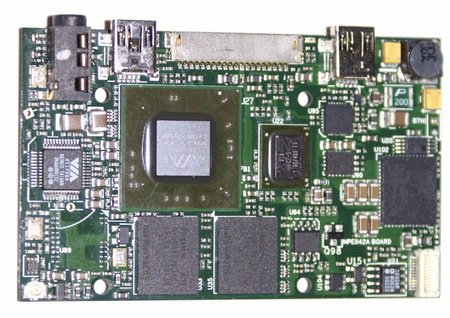World’s smallest x86-based Internet tablet?
Jan 14, 2008 — by Eric Brown — from the LinuxDevices Archive — 31 views [Updated Jan. 16] — Chipmaker Via teamed with a Taiwanese government-sponsored R&D organization to demonstrate a tiny digital TV running Ubuntu Linux on a 1GHz x86-compatible processor. The 3.3-inch-square “MTube” is positioned as the “world's smallest x86 PC,” and the first “IMP” (Internet Media Player) with TV recording capabilities.
[Updated Jan. 16] — Chipmaker Via teamed with a Taiwanese government-sponsored R&D organization to demonstrate a tiny digital TV running Ubuntu Linux on a 1GHz x86-compatible processor. The 3.3-inch-square “MTube” is positioned as the “world's smallest x86 PC,” and the first “IMP” (Internet Media Player) with TV recording capabilities.
digg this story |
Shown off at the [email protected]'s 2008 event at CES, the 5.3-ounce MTube measures 3.3 x 3.3 x 0.8 inches (8.3 x 8.3 x 2cm), and sports a 2.8-inch VGA (640 x 480) touch panel display. There's built-in WiFi, with optional WiMax and HSDPA cellular networking via USB adapters.



The MTube in action
(Click to enlarge)
The MTube was shown decoding a simulated digital TV (DVB-T) broadcast. It was also shown streaming video to a wirelessly connected digital photo frame. Perhaps most impressively, it was shown playing YouTube video — a capability that has proven to be a challenge for Linux-based tablets based on non-x86 architectures, such as Nokia's ARM11-based N800 and N810 (although a new firmware release for the Nokia devices aims to change that).
In addition to playing video in a variety of formats, the MTube can also record up to 8GB of video to its built-in flash storage. Another advanced feature is PIP (picture-in-picture).
There's also a full browser — likely Firefox — supporting “Web 2.0” content. Via's demo of the device featured Google Maps, looking a little cramped but all there on the 2.8 inch screen.
MTube demo's
(Source: Via, and ViaArena)
 Motorola DH-01 (Click for details) |
Via claims the MTube will provide up to four hours of battery life. If true, embedded x86 may really be able to compete with embedded architectures such as ARM in ultra portable devices; Motorola also claims four hours of battery life for its newly unveiled ARM11-based Motorola DH-01 portable digital TV.
Meanwhile, ARM-based devices like Nokia's Linux-based Internet tablets — much like cellphones — typically offer up to a week or two of intermittent use, eight or 10 hours of music playback, and four-five hours of steady use, for example browsing the Web. Historically, embedded architectures like ARM have offered much lower idle power than x86, although companies including Intel are working to solve the problem.
The MTube was apparently created by the Taiwan government-funded Science and Technology Advisory Group. It was demonstrated at CES last week by Chen-Mou Cheng, of the Taiwan National University. Cheng said, “We're in the process of transferring the technology to some OEMs in Taiwan, and we hope this thing can be shipped in Q2 this year.”
What's under the hood?
The MTube is based on Via's Mobile-ITX design, which was unveiled more than a year ago. Aimed at bringing the x86 architecture to mobile device form-factors, the credit card-sized Mobile-ITX module is based on Via's C7-M clocked at 1GHz, and supported by a CX700 combined northbridge/southbridge.

Mobile-ITX board prototype
(Click to enlarge)
 Wenchi Chen unveils Mobile-ITX (Click for details) |
The basic specs revealed so far for the MTube are:
- Processor: Via 1GHz C7-M
- 256MB of RAM
- I/O: Built-in WiFi, USB-based WiMax, USB-based HSDPA
- Codecs: MPEG, H.264, WMV, RMVB, MOV, FLV, DIVX
- Display: 2.8-inch touch panel (640×480)
- Hard disk: 8GB
- Battery life: 4 hours
- Dimension: 3.3 x 3.3 x 0.8 inches (8.5 x 8.5 x 2 cm)
- Weight: 5.3 ounces (150 grams)
- Operating system: Tailored Ubuntu Linux
The ultra-low-voltage C7-M was introduced in March 2006. At the time it was claimed by Via to have the highest performance-per-Watt, smallest packaging, and fastest cryptographic engine of any available x86-compatible processor. Via sells two 1GHz C7-M models: the 770, which uses 5 Watts and the 779, which needs only 3.5 Watts.
This article was originally published on LinuxDevices.com and has been donated to the open source community by QuinStreet Inc. Please visit LinuxToday.com for up-to-date news and articles about Linux and open source.